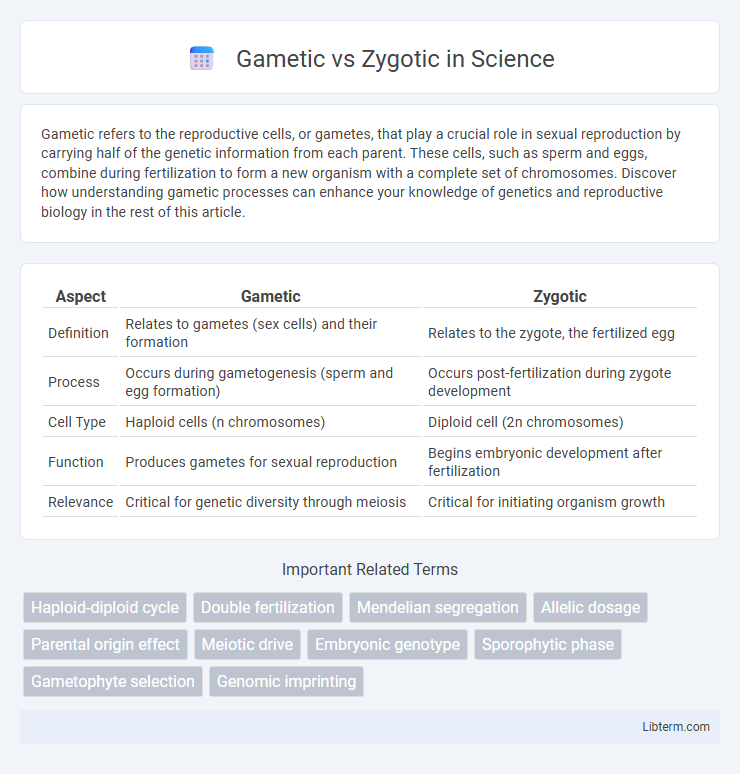Gametic refers to the reproductive cells, or gametes, that play a crucial role in sexual reproduction by carrying half of the genetic information from each parent. These cells, such as sperm and eggs, combine during fertilization to form a new organism with a complete set of chromosomes. Discover how understanding gametic processes can enhance your knowledge of genetics and reproductive biology in the rest of this article.
Table of Comparison
| Aspect | Gametic | Zygotic |
|---|---|---|
| Definition | Relates to gametes (sex cells) and their formation | Relates to the zygote, the fertilized egg |
| Process | Occurs during gametogenesis (sperm and egg formation) | Occurs post-fertilization during zygote development |
| Cell Type | Haploid cells (n chromosomes) | Diploid cell (2n chromosomes) |
| Function | Produces gametes for sexual reproduction | Begins embryonic development after fertilization |
| Relevance | Critical for genetic diversity through meiosis | Critical for initiating organism growth |
Introduction to Gametic and Zygotic Concepts
Gametic and zygotic stages represent crucial phases in the life cycle of sexually reproducing organisms, where gametic refers to the haploid cells (sperm and egg) responsible for sexual reproduction, and zygotic denotes the diploid cell formed by the fusion of these gametes. Gametes carry half the genetic information of an organism, enabling genetic diversity through recombination during fertilization. The zygotic stage initiates the development of a new organism, marking the beginning of mitotic cell divisions and embryogenesis essential for growth.
Definition of Gametic Inheritance
Gametic inheritance refers to the transmission of genetic material through gametes, specifically sperm and egg cells, during sexual reproduction. This type of inheritance ensures that offspring receive a combination of genetic traits from both parents, contributing to genetic diversity. The genetic information carried in the haploid gametes merges during fertilization to form a zygote with a diploid set of chromosomes.
Understanding Zygotic Inheritance
Zygotic inheritance refers to the genetic traits passed from the fertilized egg, or zygote, carrying combined DNA from both gametes--sperm and egg. Unlike gametic inheritance, which involves genetic information within individual sex cells before fertilization, zygotic inheritance determines the unique genotype of the offspring by merging parental alleles during zygote formation. This process is fundamental in Mendelian genetics and explains how traits are expressed in diploid organisms through dominant and recessive allele interactions.
Key Differences: Gametic vs. Zygotic
Gametic and zygotic phases represent distinct stages in the life cycle of sexually reproducing organisms, with gametic cells being haploid and responsible for sexual reproduction through the fusion of two gametes. In contrast, the zygotic phase begins with the formation of a diploid zygote resulting from gamete fusion, marking the commencement of a multicellular organism's development. Key differences include genetic composition, with gametes containing half the genetic material and zygotes possessing a full set of chromosomes, and their roles in reproduction, where gametes enable genetic diversity and zygotes initiate organismal growth.
Biological Processes Involved
Gametic and zygotic phases represent distinct biological processes in sexual reproduction, where gametic involves the formation and fusion of haploid gametes through meiosis, while zygotic centers on the diploid zygote's development via mitotic divisions. Meiosis reduces chromosome numbers by half, producing genetically diverse sperm and egg cells, whereas zygotic mitosis promotes cellular differentiation and organismal growth. Key molecular mechanisms include synapsis and recombination during gametogenesis, and gene expression regulation during zygotic embryogenesis.
Gametic and Zygotic Phases in Life Cycles
The gametic phase in life cycles involves the production of gametes through meiosis, where haploid cells are formed to facilitate sexual reproduction. The zygotic phase begins with the fusion of these gametes, creating a diploid zygote that undergoes mitotic divisions to develop into a mature organism. Understanding the transition between gametic and zygotic phases is essential for studying reproductive strategies and genetic variation in organisms.
Genetic Implications and Consequences
Gametic mutations occur in gametes and directly affect offspring by introducing new genetic variations that can be inherited across generations, potentially leading to genetic disorders or increased genetic diversity. Zygotic mutations arise after fertilization in the zygote and result in mosaicism, where only some cells carry the mutation, reducing the risk of transmission to progeny but possibly causing somatic disorders. The genetic consequences of gametic mutations are more profound for population genetics, influencing allele frequencies, while zygotic mutations primarily impact individual phenotypes and somatic cell lines.
Examples in Plants and Animals
Gametic reproduction involves the fusion of gametes, such as sperm and egg cells, as seen in animals like humans (Homo sapiens) and plants like flowering species (angiosperms). Zygotic reproduction centers on the zygote as the pivotal stage, common in lower plants such as algae (Chlamydomonas) and fungi where the zygote undergoes meiosis directly. Examples in animals for zygotic life cycles include certain protozoans, while gametic cycles dominate complex multicellular organisms like mammals and flowering plants.
Importance in Evolution and Breeding
Gametic isolation prevents gene flow between species by stopping fertilization, maintaining species integrity and driving speciation in evolution. Zygotic isolation occurs after fertilization, where hybrid zygotes fail to develop or are non-viable, ensuring reproductive boundaries and genetic divergence. Both mechanisms are crucial in breeding programs to control hybridization, improve trait selection, and maintain genetic diversity in crops and livestock.
Conclusion: Gametic vs. Zygotic Significance
Gametic and zygotic stages represent crucial phases of sexual reproduction, with gametic referring to haploid cells (gametes) and zygotic to the diploid fertilized cell (zygote). The significance of the gametic phase lies in genetic diversity generation through meiosis, while the zygotic phase ensures the stability and continuity of species by developing into a multicellular organism. Understanding the distinction between gametic and zygotic stages is essential for studying genetic inheritance, developmental biology, and reproductive strategies.
Gametic Infographic

 libterm.com
libterm.com